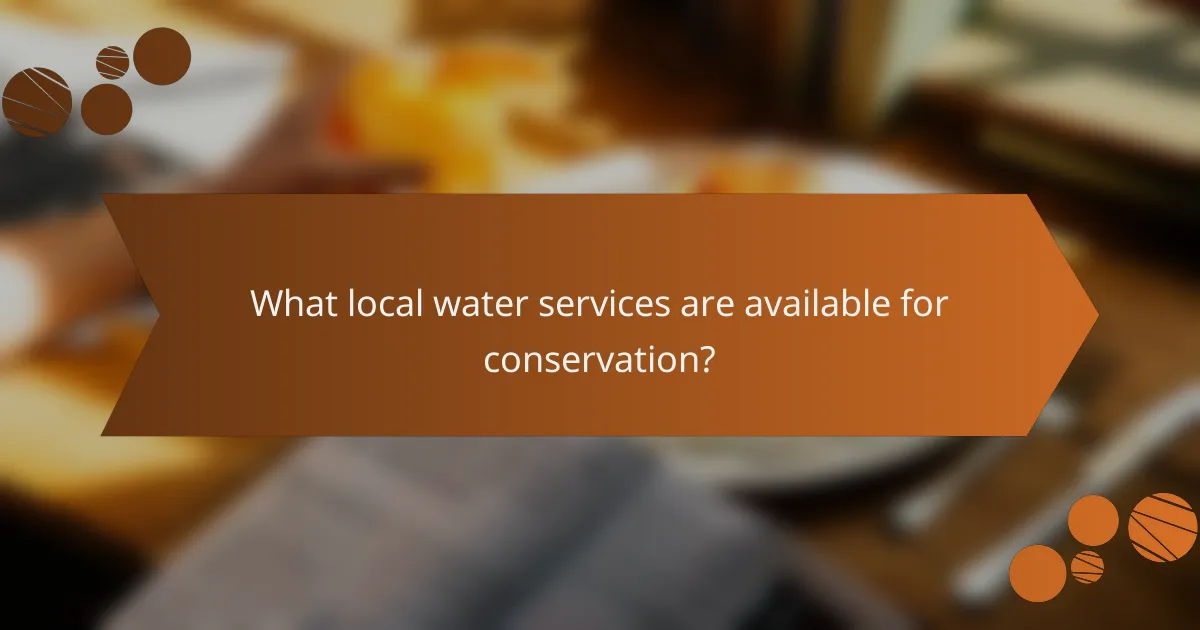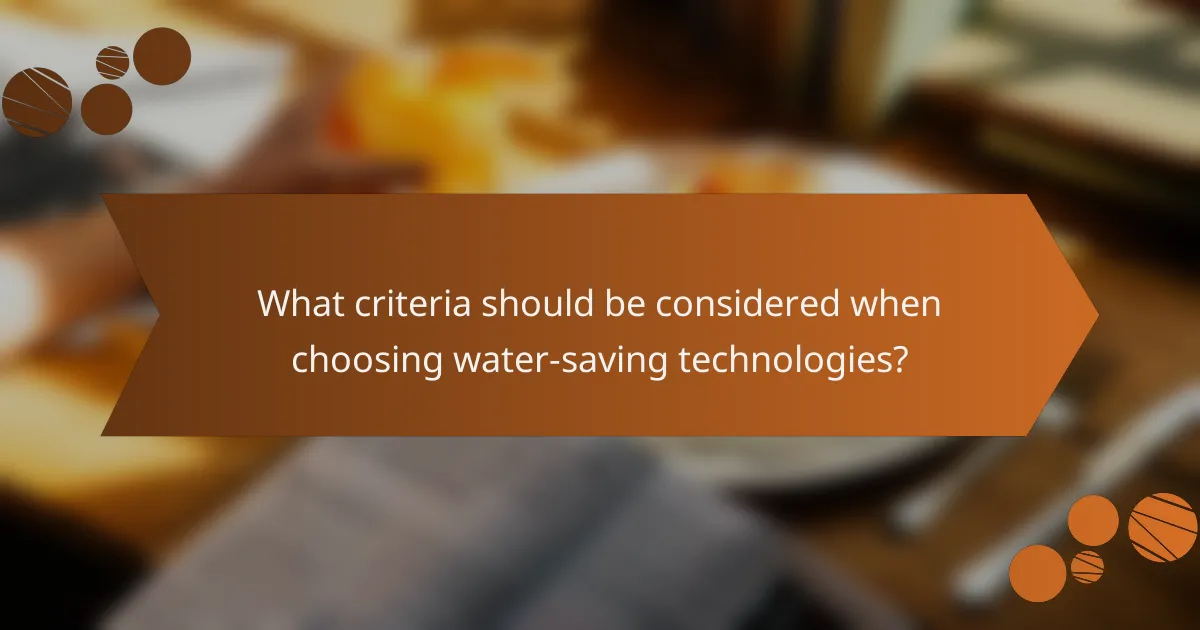Water conservation is essential for sustainable living, especially in regions facing water scarcity. By adopting effective water-saving tips and efficient practices, both households and businesses can significantly reduce their water consumption while also lowering utility costs. Local water services offer valuable resources and incentives to support these efforts, making it easier for communities to implement lasting solutions for water efficiency.

What are effective water-saving tips for households in Los Angeles?
Households in Los Angeles can significantly reduce their water usage by implementing various effective strategies. These practices not only conserve water but also help in managing utility bills and promoting sustainability in the region.
Install low-flow fixtures
Low-flow fixtures, such as showerheads and faucets, can reduce water consumption by up to 50% compared to standard models. When selecting fixtures, look for those labeled with the WaterSense label, which indicates they meet efficiency standards set by the EPA.
Replacing older toilets with high-efficiency models can also lead to substantial savings, as modern toilets use about 1.28 gallons per flush, compared to older models that may use 3.5 gallons or more. Consider retrofitting existing toilets with a dual-flush mechanism for additional savings.
Use drought-resistant landscaping
Drought-resistant landscaping, or xeriscaping, involves using native plants that require minimal water. This approach not only conserves water but also enhances local biodiversity and reduces maintenance costs.
When planning your garden, choose plants that thrive in the local climate, such as succulents and California poppies. Incorporating mulch can also help retain soil moisture and reduce the need for frequent watering.
Fix leaks promptly
Addressing leaks quickly is crucial for conserving water. A small leak can waste hundreds of gallons per month, so regularly check faucets, toilets, and irrigation systems for signs of dripping or pooling water.
Consider using a water meter to monitor usage and identify any unexpected increases that may indicate a leak. Repairing leaks not only saves water but also prevents potential damage to your home.
Limit outdoor watering
In Los Angeles, outdoor watering is often restricted during drought conditions. To conserve water, limit watering to early morning or late evening when evaporation rates are lower, and consider using a drip irrigation system for more efficient delivery.
Be mindful of local regulations regarding watering days and times, which can vary seasonally. Aim to water only when necessary, and adjust your schedule based on rainfall and seasonal changes.
Collect rainwater
Collecting rainwater is an effective way to supplement your water supply for irrigation. Installing a rain barrel can capture runoff from your roof, allowing you to use this water for landscaping during dry periods.
Ensure your rainwater collection system complies with local regulations, as there may be guidelines on how to store and use collected water. This practice not only conserves municipal water but also reduces stormwater runoff, benefiting the environment.

How can businesses implement water-efficient practices?
Businesses can implement water-efficient practices by assessing their current water usage, upgrading equipment, and educating employees on conservation techniques. These steps not only reduce costs but also contribute to environmental sustainability.
Conduct water audits
Conducting water audits helps businesses identify areas where water is being wasted and where efficiency can be improved. This process typically involves analyzing water bills, measuring water flow rates, and inspecting fixtures and appliances.
To perform an audit, consider hiring a professional or using a checklist to evaluate water usage in different areas, such as restrooms, kitchens, and landscaping. Regular audits can lead to significant savings, often in the range of 20-30% of total water usage.
Upgrade to water-efficient appliances
Upgrading to water-efficient appliances is a crucial step in reducing water consumption. Look for products with the WaterSense label, which indicates they meet EPA standards for efficiency.
Examples include low-flow faucets, dual-flush toilets, and ENERGY STAR-rated dishwashers and washing machines. These appliances can reduce water usage by 20-50%, leading to lower utility bills and a smaller environmental footprint.
Train staff on water conservation
Training staff on water conservation practices is essential for fostering a culture of sustainability within the business. Employees should be educated on the importance of water efficiency and how their actions can impact overall usage.
Consider implementing regular training sessions and providing easy-to-follow guidelines, such as fixing leaks promptly, turning off taps when not in use, and using water-efficient cleaning methods. Engaging staff in conservation efforts can enhance commitment and lead to lasting changes in behavior.

What local water services are available for conservation?
Local water services play a crucial role in promoting conservation through various programs and initiatives. These services often provide resources, education, and financial incentives to help residents and businesses reduce water usage effectively.
Los Angeles Department of Water and Power programs
The Los Angeles Department of Water and Power (LADWP) offers several programs aimed at enhancing water conservation. These include rebates for water-efficient appliances, such as washing machines and toilets, which can significantly reduce water consumption.
Additionally, LADWP provides free water-saving devices, such as showerheads and faucet aerators, to residents. By participating in these programs, households can lower their water bills while contributing to the city’s overall conservation efforts.
Community workshops on water efficiency
Community workshops focused on water efficiency are regularly organized by local agencies and organizations. These workshops educate participants on practical water-saving techniques, such as xeriscaping, which involves landscaping that reduces or eliminates the need for irrigation.
Attendees can learn about the importance of monitoring water usage and identifying leaks, which can waste significant amounts of water. Engaging in these workshops fosters a community-oriented approach to conservation, encouraging residents to share tips and strategies.
Incentives for water-saving devices
Incentives for purchasing water-saving devices are available through various local programs. Residents can receive rebates for installing efficient irrigation systems, rain barrels, and smart controllers that optimize water use based on weather conditions.
These incentives not only help offset the initial costs of these devices but also promote long-term savings on water bills. It’s essential to check eligibility requirements and application processes to maximize the benefits of these programs.

What are the benefits of water conservation?
Water conservation offers numerous advantages, including cost savings and environmental protection. By using water more efficiently, individuals and communities can reduce their utility expenses while promoting sustainability.
Reduced utility bills
Conserving water directly leads to lower utility bills. When households use less water, they pay less for water supply and sewage services, which can result in savings of tens of percent on monthly bills.
Simple practices like fixing leaks, using water-efficient fixtures, and reducing lawn watering can significantly decrease water consumption. For example, replacing an old toilet with a low-flow model can save several thousand liters of water annually.
Environmental sustainability
Water conservation plays a crucial role in protecting the environment. By using less water, we help preserve local ecosystems and reduce the strain on natural water sources, which is vital for maintaining biodiversity.
Efficient water use can also decrease energy consumption associated with water heating and treatment. This reduction in energy use contributes to lower greenhouse gas emissions, supporting broader efforts to combat climate change.
Improved community water supply
When individuals conserve water, it contributes to a more reliable water supply for the entire community. This is especially important in areas facing drought or water scarcity, where every drop counts.
Communities can benefit from collective water-saving efforts, leading to better management of local water resources. Initiatives like rainwater harvesting and greywater recycling can enhance water availability for everyone, ensuring sustainable access for future generations.

What criteria should be considered when choosing water-saving technologies?
When selecting water-saving technologies, consider efficiency ratings, installation costs, and the specific needs of your household or business. These factors will help you determine the best solutions that balance performance and affordability.
Efficiency ratings
Efficiency ratings indicate how effectively a water-saving technology reduces water usage compared to standard options. Look for products with high efficiency ratings, often expressed as a percentage, to ensure significant water conservation.
For example, low-flow showerheads may have efficiency ratings of 30-50% compared to traditional models. Similarly, dual-flush toilets can save up to 67% more water than single-flush toilets, making them a smart choice for reducing water consumption.
Cost of installation
The cost of installation for water-saving technologies can vary widely based on the type of system and local labor rates. Budget for both the purchase price of the technology and any additional costs for professional installation, which can range from low hundreds to several thousand dollars.
Consider the long-term savings on your water bill when evaluating installation costs. For instance, while a high-efficiency washing machine may have a higher upfront cost, it can save you significant amounts on water and energy bills over time, often recouping the initial investment within a few years.
